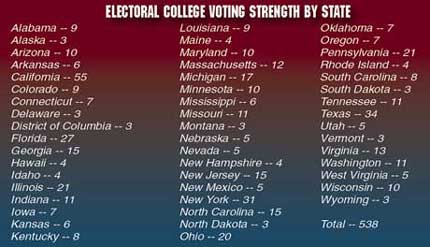| When
American voters go to the polls to vote for president, many believe
that they are participating in a direct election of the president. Technically,
this is not the case, due to the existence of the electoral college,
a constitutional relic of the 18th century.
The electoral college is the name given a group of "electors"
who are nominated by political activists and party members within the
states. On election day, these electors, pledged to one or another candidate,
are popularly elected. In December following the presidential vote,
the electors meet in their respective state capitals and cast ballots
for president and vice president. To be elected, a president requires
270 electoral votes.
It is possible that in a close race or a multiparty race the electoral
college might not cast 270 votes in favor of any candidate — in that
event, the House of Representatives would choose the next president.
The electoral college system was established in Article II, Section
I, of the U.S. Constitution. While it has been the subject of mild controversy
in recent years, it is also seen as a stabilizing force in the electoral
system.
HOW THE
ELECTORAL COLLEGE WORKS TODAY
• Registered voters
in the 50 states and the District of Columbia cast ballots for president
and vice president on the first Tuesday following the first Monday in
November in a presidential election year.
• The candidates who win the popular vote within the state usually receive
all the state's electoral votes. (Technically, all the electors pledged
to those candidates are elected.)
• A state's number of electors equals the number of senators and representatives
from that state. The District of Columbia, which has no voting representation
in Congress, has three electoral votes.
• The electors meet and officially vote for president and vice president
on the first Monday following the second Wednesday in December in a
presidential election year. A majority of the vote is required for a
candidate to be elected. Since there are 538 electors, a minimum of
270 is necessary to win the electoral college.
• If no candidate for president receives a majority of the electoral
votes, the House of Representatives must determine the winner from among
the top three vote-getters in the electoral college. In doing so, members
of the House vote by states, with each state delegation casting one
vote.
• If no candidate for vice president receives a majority of the electoral
vote, the Senate must determine the winner from among the top two vote-getters
in the electoral college.
The president and
vice president take their oath and assume office on the next January
20, following the election.

|

